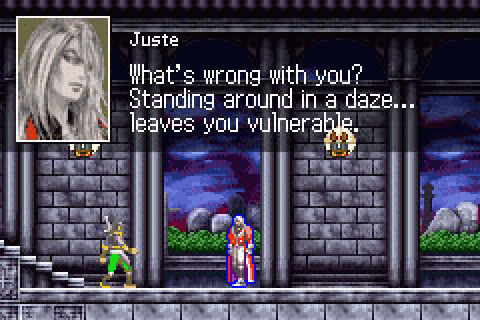 |
Castlevania: Harmony of Dissonance - Review |
 |
Lateral Progression
By: Jake Alley
| Review Breakdown |
| Battle System |
4 |
| Interface |
8 |
| Music/Sound |
2 |
| Originality |
5 |
| Plot |
2 |
| Localization |
5 |
| Replay Value |
7 |
| Visuals |
8 |
| Difficulty |
Easy |
| Time to Complete |
4-8 hours
|
|
| Overall |
 |
| Criteria
|
Castlevania: Symphony of the Night was one of the best received games
the PlayStation had to offer. While Castlevania:
Circle of the Moon revived Symphony's Metroid style gameplay, and was also met with much
acclaim, fans of the PlayStation title still wished for something a bit closer. This brings us to
Castlevania: Harmony of Dissonance.
The first thing one notices in Harmony of Dissonance is just how much it looks like
Symphony of the Night. Even the main character looks extremely similar, maintaining the long white
hair and trenchcoat look. Even the trailing blue aura sported in Symphony makes a return, although
in this case the purpose is more practical than cosmetic. Aside from the blue trails left by the
main character, all the characters, monsters, and backgrounds in Harmony of Dissonance have been
designed bright, high contrast pallettes in response to the primary complaint people had of the previous
Castlevania being simply too dark for the GBA's non-backlit screen. In addition to drastically improving
the visibility, this gives a much needed facelift to the monsters, most of which had never been redesigned
since the series first made the leap to the Super Nintendo.
Unfortunately, while Harmony of Dissonance provides graphics to rival the best
the series has ever offered, the music falls quite flat. Even going back to the days of the NES,
the Castlevania series has always been known for featuring an extremely high quality and memorable
soundtrack, with many tunes returning game after game. Harmony on the other hand features a collection
of tinny tracks that fail to even live up to the standards of its 8-bit ancestors.

|
| Bright yet still dark.
|
|
Moving on to the gameplay, Harmony of Dissonance offers a mixed bag. On the one
hand, it requires players to make their way through two parallel castles, occasionally solving
puzzles and allowing them to progress in a very open-ended fashion. It also features some very tight
controls, and allows players to swing their whips about in either the freestyle fashion of Castlevania
4, or the circular spin of Circle of the Moon. On the other hand, Harmony of Dissonance is a shockingly
easy game, particularly when compared to last year's Circle. The complexity of gameplay is also
cut back quite a bit. While Circle of the Moon had players searching for cards to combine, forming
a hundred different spells, Harmony has an exceedingly simple magic system, with little real impact
on the game at all.
The most unusual feature about Harmony of Dissonance however is the way it handles
saving. Like its predecessors, the game can be saved at save points scattered around the castle.
However, in concession to the portable platform's limited battery life, an option to save on the go is also included.
Most games with such a feature opt to restrict it by only allowing the game to be saved on the
go when returning to the title screen, and erasing this temporary file as it's loaded. Harmony of
Dissonance on the other hand allows the game to be saved at any time when not fighting a boss and
continue play. The only limiting factor on this is that the player will be returned to the last
save point visited when loading their game. Although this was intended as a drawback, it is actually
highly beneficial to the player. This reviewer for example frequently took advantage of this by
quick-saving and resetting after getting any out of the way item, sparing me the long trip back.

|
| Albino Belmont |
|
On a similar note of irony comes the story of Harmony of Dissonance. After over
a dozen games regurgitating the story of "Dracula has been resurrected, go kill him!" the series
finally tries something different. However, this new original story seems even more contrived and
trite than the tired-but-familiar gimmick. This vague sense of apathy also extends to the creativity
of the game's layout. The titular castle has the same rough layout as it did in both Symphony of
the Night and Circle of the Moon, but with much smaller and emptier hallways. Granted, there is
a mirror version of the castle, but the layout and appearance of areas is nearly identical in each.
Harmony of Dissonance is, all and all, a highly enjoyable game in the Metroid vein, which will almost
certainly rekindle memories of Symphony of the Night. Under the surface however, there isn't quite
enough meat to let the game stand on its own as a classic.
|










